Examples of electronic/electrical appliances are
- household appliances ("white goods")
- home entertainment equipment ("brown goods")
- office equipment/communications equipment
- computers/computer peripherals, photocopiers, air conditioners
- precision mechanical/optical equipment (e.g. microscopes, cameras, enlargers)
Such goods are transported in standard containers, subject to compliance with limits for water content of packaging and container floor.
Undamaged, dry containers must be used for transport. Packed containers should be closed with seals and the numbers recorded in the shipping documents.
Transport instructions and damage
Packaging
Electronic/electrical appliances are mainly transported in cartons, sometimes also in cases and crates, often using preformed foam inserts to secure the contents in the packages. Wood wool and corrugated board should no longer be used as internal packaging as they are hygroscopic (WCC 2) and there is a risk of condensation in the event of temperature changes. Non-hygroscopic packaging materials are best, i.e. foams which can neither contain nor absorb water (WCC 0), such as for example polystyrene, polyurethane, which are used in many different forms, for example as moldings (see Figs. 197, 198, 199) or as pourable chips (see Fig. 200) or they may be foamed in place. Airbags (see Fig. 201) and bubble film (see Fig. 202) are also effective. Goods which are palletized in accordance with the modular system and enclosed in sufficiently thick shrink film are favorable. Skids (sleds) are used for heavy packages.
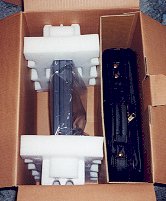 |
 |
| Fig. 197: Laptop computer in corrugated board carton with preformed polystyrene foam inserts to secure the contents; Photo: Ragna Scharnow |
Figure 198: Home entertainment equipment (brown goods) with preformed polystyrene foam inserts to secure the contents; Photo: Ragna Scharnow |
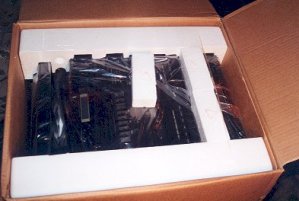 |
Figure 199: Home entertainment equipment (brown goods) with preformed polystyrene foam inserts to secure the contents; Photo: Ragna Scharnow |
| Figure 200: Plastic pellets as filling material; Photo: U. Scharnow |
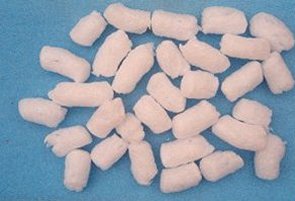 |
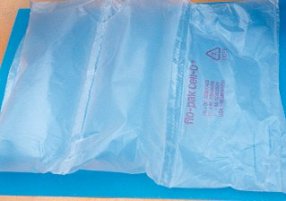 |
Figure 201: Airbag; Photo: Ragna Scharnow |
| Figure 202: Bubble film; Photo: Ragna Scharnow |
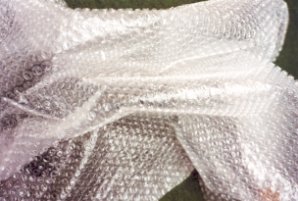 |
All packages must be labeled and marked in accordance with relevant standards. For example, "upside-down" stowage of such appliances may cause liquid to leak from pre-installed containers, resulting in a total loss (oil, chemicals, toner).
In the case of particularly high value and sensitive appliances, shock and/or tilt indicators should be attached. Such indicators may also have positive psychological effect, which should not be underestimated, encouraging careful handling of the goods.
Humidity/Moisture
Manufacturers generally specify very low relative humidities, e.g. 35 - 65%, for IT equipment. Water vapor adsorption may, for example, result in an increase in the self-capacitance of high frequency coils, or a reduction in the insulation resistance of paper capacitors or the dielectric strength of insulating materials. Such goods must accordingly be protected from all forms of moisture. Electrical products thus require particularly careful corrosion protection. No coating methods are usable, as coatings cannot be removed from sensitive appliances and fundamentally impair proper function. It is primarily the desiccant method which is used. Appliances are heat-sealed in film together with desiccants. Depending upon the composition of metals, the VCI method may also be used.
Contamination
Electronic/electrical appliances are extremely sensitive to contamination by dust. Absolute cleanliness is required in warehouses and containers which are to be packed. Dust in the air may result in damage. This sensitivity to contamination even extends to air pollution, in particular due to hydrogen sulfide (H2S) (see Fig. 203). Hydrogen sulfide reacts with silver to form silver sulfide (Ag2S), which results in the formation of a black film of insulating sulfides on the surface of silvered circuit contacts and relays and on silvered conductors (e.g. coils).

| Figure 203: Influence of relative humidity and air pollution on the rusting of steel; Grundke [13] a) pure air (even in the presence of charcoal particles) b) traces of ammonium sulfate on the surface c) traces of sulfur dioxide in the air d) presence of ammonium sulfate and traces of sulfur dioxide e) presence of charcoal particles and traces of sulfur dioxide |
Sulfur dioxide (SO2) and sulfur trioxide (SO3) also have a corrosion-promoting action if these gases are dissolved in mist droplets; combined with water, they form H2SO3 or H2SO4.
Sensitivity to impact and jolting
Proper stowage and cargo securing within container, especially for LCL containers, together with compliance with stowage and handling symbols are absolutely essential.
The use of shrink film is advisable for palletized goods. Improper stowage has a serious impact on container shipments; problems include exceeding the maximum stacking height, incorrect cargo securing within the container, as well as damage caused by forklift trucks during packing and unpacking of the container and inadmissible hard impacts.
Heavy packages such as air conditioners and photocopiers are particularly sensitive to impact and vibration. Such packages should be placed on vibration dampers.
When packing and unpacking containers with ground conveyors, care must be taken to protect the appliances from battering. Especially when switch cabinets or large appliances are mounted directly on a pallet and are there enclosed in a sealed package, handling must be carried out with extreme care as damage to the sealed package would make the corrosion protection measures ineffective.
Risk of theft
Electronic/electrical appliances are extremely valuable, consumer-oriented goods which are consequently at considerable risk of theft. As a result, such cargoes are not only of interest to opportunist thieves, but are increasingly attracting international criminal organizations. It is not unusual for entire container loads to be taken or fraudulently diverted to other "receivers". This is often achieved thanks to insider information or illegal access to transport data and hacking into internal computer networks.
Company names and appliance details printed on packaging increase opportunist theft and such details should accordingly remain neutral (see Fig. 204).
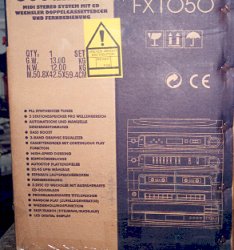 |
Figure 204: This detailed information invites theft. Photo: Ragna Scharnow |
In the case of theft, packaging units are often cleverly manipulated. Before goods are packed into the container, it should therefore be checked that the packaging is still in its original state. Providing that circumstances permit (e.g. customs inspections/checks of metal seals), the containers should be stowed with the doors of adjacent containers facing towards each other.
Insect infestation
Insect infestation need not generally be expected; however, damage may be caused to the packaging by creatures which mistakenly find their way in, such as beetles and beetle larvae. In their search for new breeding grounds, pests can destroy the packaging.
The common packaging materials paper and paperboard (corrugated board is the most susceptible) and most plastic films do not offer full protection against insect infestation. Creased packaging materials exhibit lower resistance than smooth materials because insects preferentially attack folded materials.
Before packing, the container must be examined for the absence of pests. Insect-resistant packaging is preferred. When wooden packaging materials or cargo securing materials are used, it may, under certain circumstances, be necessary to comply with the quarantine regulations of the country of destination and a copy of the wood treatment certificate may have to be placed in a highly visible location on the container. In the case of container transport to Australia and New Zealand, proof of adequate treatment against the sirex wasp must be provided.
In some cases, problems with rodents may arise during storage of the appliances before or after shipment. In particular, if such animals are unintentionally locked into the container on completion of packing, they can cause considerable damage to packaging, casings and possibly pipework etc., which may result in malfunctioning.